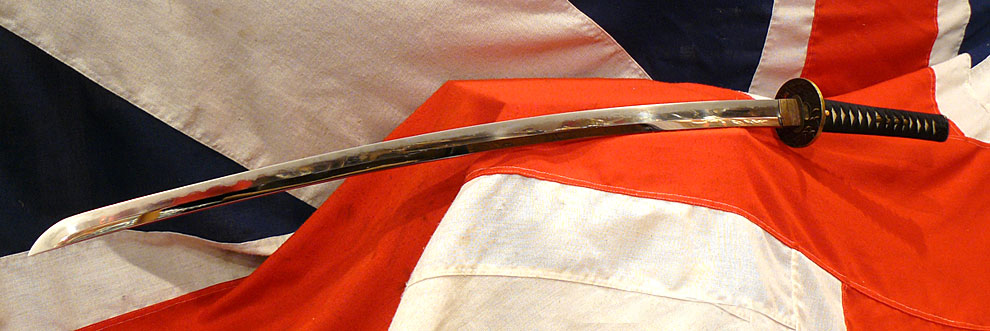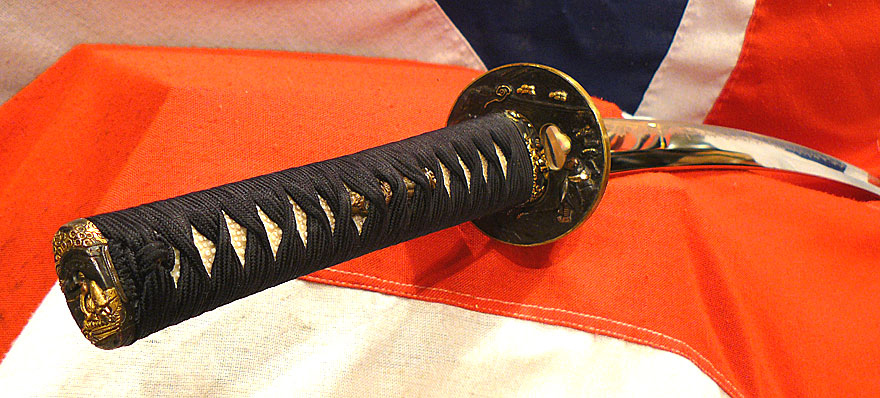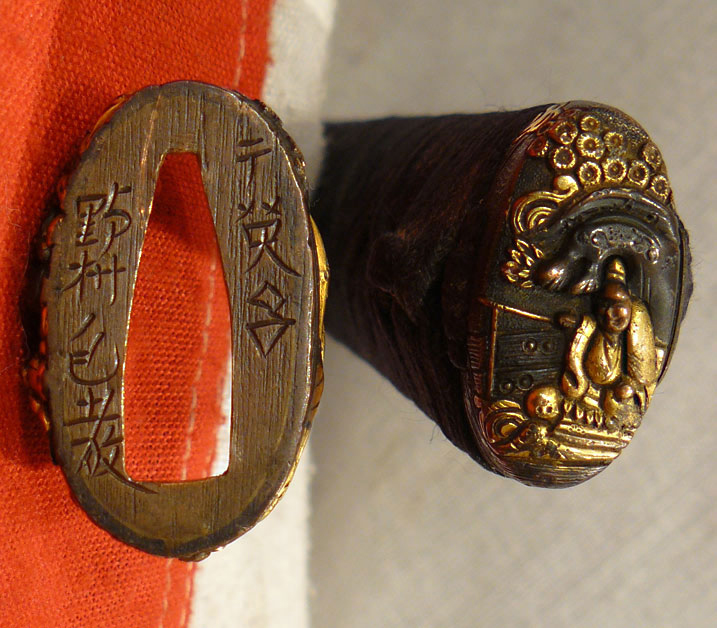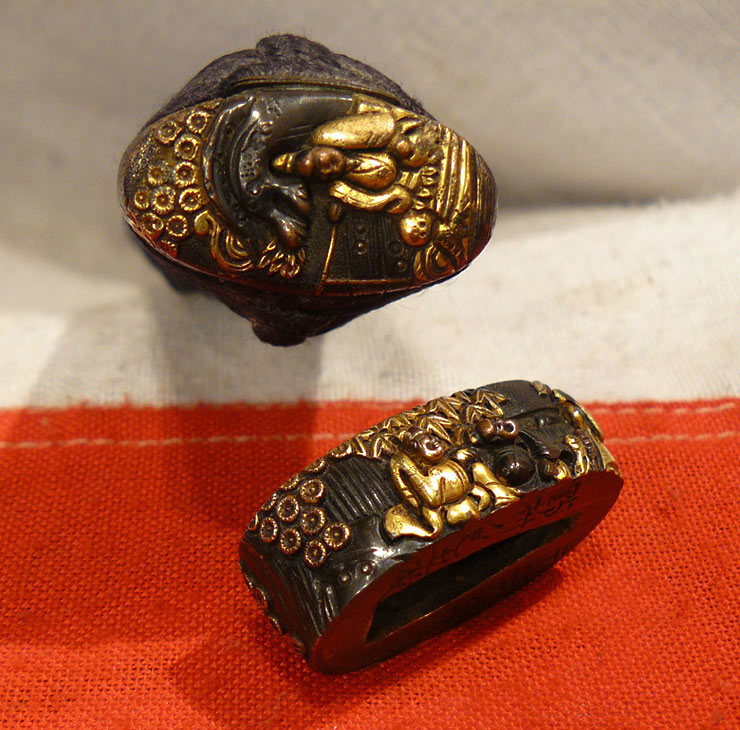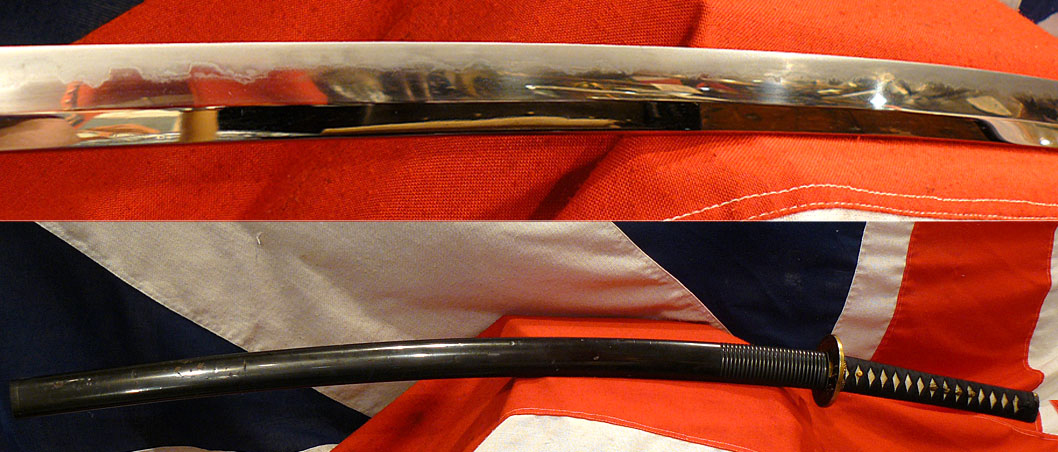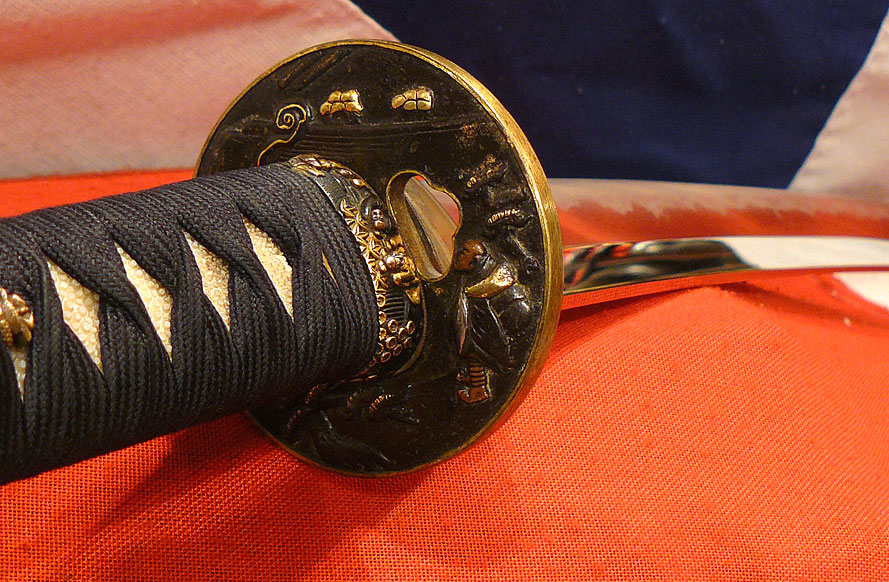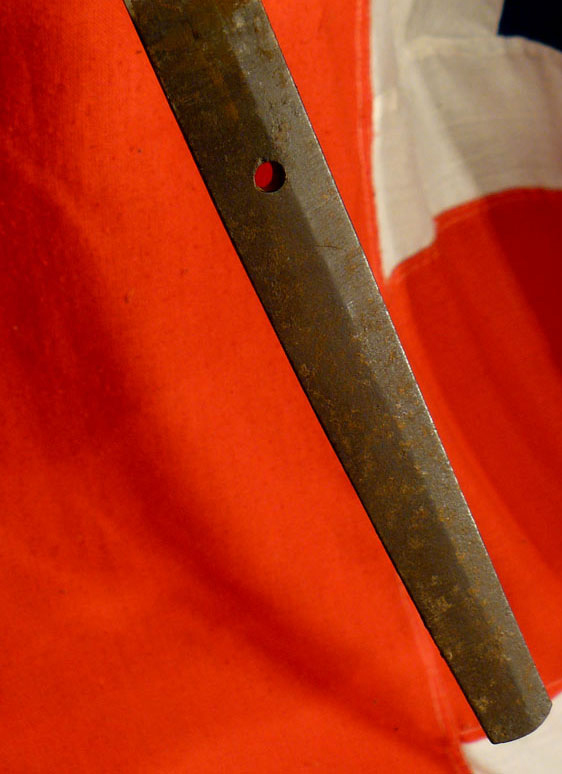A Simply Magnificent 17th Century Samurai Katana with Signed Soten Gold and Shakudo Mounts. A Spectacular Museum Grade Katana
This is a most stunning high ranking samurai's sword. Made and used at the beginning of the great Japanese Edo period. The blade has a wondrous hamon, shown in all it's beauty. All of the fittings are very fine and the overall effect is simply wonderful. A singularly fine museum quality quality katana, with a full suite of, original, Edo period, signed Soten, gold and patinated copper fittings. This is truly a sword of great beauty, worthy of any top ranked collection of the most beautiful swords of the Japanese samurai.
The saya is original Edo period in black urushi in a two section design, with a partially deeply ribbed lacquer top section.
A revolution took place in the centuries from the time of the Kamakura shogunate, which coexisted with the Tenno's court, to the Tokugawa, when the bushi became the unchallenged rulers in what historian Edwin O. Reischauer called a "centralized feudal" form of government. Instrumental in the rise of the new bakufu was Tokugawa Ieyasu, the main beneficiary of the achievements of Oda Nobunaga and Toyotomi Hideyoshi. Already powerful, Ieyasu profited by his transfer to the rich Kanto area. He maintained 2.5 million koku of land, new headquarters at Edo, a strategically situated castle town (the future Tokyo), and also had an additional two million koku of land and thirty-eight vassals under his control. After Hideyoshi's death, Ieyasu moved quickly to seize control from the Toyotomi family.
Ieyasu's victory over the western daimyo at the Battle of Sekigahara (October 21, 1600, or in the Japanese calendar on the 15th day of the ninth month of the fifth year of the Keichi era) gave him virtual control of all Japan. He rapidly abolished numerous enemy daimyo houses, reduced others, such as that of the Toyotomi, and redistributed the spoils of war to his family and allies. Ieyasu still failed to achieve complete control of the western daimyo, but his assumption of the title of shogun helped consolidate the alliance system. After further strengthening his power base, Ieyasu installed his son Hidetada (1579?1632) as shogun and himself as retired shogun in 1605. The Toyotomi were still a significant threat, and Ieyasu devoted the next decade to their eradication. In 1615, the Tokugawa army destroyed the Toyotomi stronghold at Osaka.
The Tokugawa (or Edo) period brought 250 years of stability to Japan. The political system evolved into what historians call bakuhan, a combination of the terms bakufu and han (domains) to describe the government and society of the period. In the bakuhan, the shogun had national authority and the daimyo had regional authority. This represented a new unity in the feudal structure, which featured an increasingly large bureaucracy to administer the mixture of centralized and decentralized authorities. The Tokugawa became more powerful during their first century of rule: land redistribution gave them nearly seven million koku, control of the most important cities, and a land assessment system reaping great revenues. As Japan entered the more peaceful Edo Period (1603-1868), tsuba and sword fittings became increasingly elaborate and decorative in design and function, and their manufacture became highly specialised and technically advanced. Different schools of makers developed their own styles, often influenced by the culture and environment of the region, and the role of the tsuba and mounts extended to become an elaborate piece of art. Subjects for decoration included Japanese mythology, history and nature. Since the 16th century, it was customary for the guard and mounts to feature the signature of the maker. The katana's saya has a few small Edo period contact marks throughout. It could be re-lacqured to as new condition if it was required by its new owner or left original as is. Valued for their excellence in design and execution, sword fittings today exist as refined pieces of art, and although now only used for state occasions and consecrations, the Japanese sword and its fittings remain a symbol of authority and reminder of Japan's powerful, and at times tumultuous, samurai past.
There are many reasons why people enjoy collecting swords. Some people are drawn to the beauty and craftsmanship of swords, while others appreciate their historical and cultural significance. Swords can also be a symbol of power and strength, and some collectors find enjoyment in the challenge of acquiring rare or valuable swords.
One of the greatest joys of sword collecting is the opportunity to learn about the history and culture of different civilisations. Swords have been used by warriors for millennia, and each culture has developed its own unique sword designs and traditions. By studying swords, collectors can gain a deeper understanding of the people who made and used them.
Another joy of sword collecting is the sheer variety of swords that are available. There are swords in our gallery from all over the world and from every period of history. Collectors can choose to specialize in a particular type of sword, such as Japanese katanas or medieval longswords, or they can collect a variety of swords from different cultures and time periods. No matter what your reasons for collecting swords, it is a hobby that can provide many years of enjoyment. Swords are beautiful, fascinating, and historically significant objects
As once told to us by an esteemed regular visitor to us here in our gallery, and the same words that are repeated in his book;
“In these textures lies an extraordinary and unique feature of the sword - the steel itself possesses an intrinsic beauty. The Japanese sword has been appreciated as an art object since its perfection some time during the tenth century AD. Fine swords have been more highly prized than lands or riches, those of superior quality being handed down from generation to generation. In fact, many well-documented swords, whose blades are signed by their makers, survive from nearly a thousand years ago. Recognizable features of the blades of hundreds of schools of sword-making have been punctiliously recorded, and the study of the sword is a guide to the flow of Japanese history.”
Victor Harris
Curator, Assistant Keeper and then Keeper (1998-2003) of the Department of Japanese Antiquities at the British Museum. He studied from 1968-71 under Sato Kenzan, Tokyo National Museum and Society for the Preservation of Japanese Swords
Every single item from The Lanes Armoury is accompanied by our unique Certificate of Authenticity. Part of our continued dedication to maintain the standards forged by us over the past 100 years of trading
Blade 30.3 inches long tip to tsuba, sword length 40 inches out of saya. 41 inches long overall. saya has all its original Edo lacquer finish with just a few natural age surface blemishes as to be expected.
Code: 22994
10295.00 GBP

